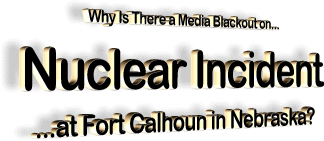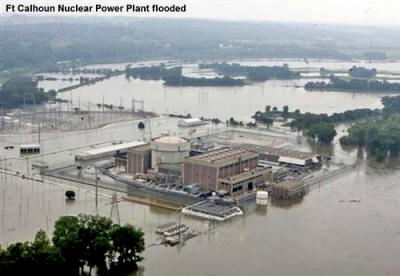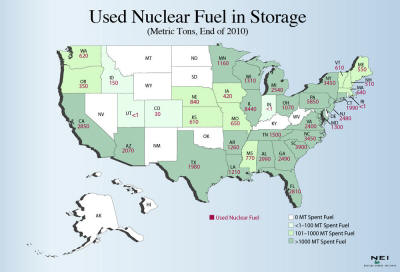|
by Patrick Henningsen
But evidence strongly suggests that something very serious has in fact happened there. On June 7th, there was a fire reported at Fort Calhoun. The official story is that the fire was in an electrical switchgear room at the plant.
The apparently facility lost power to a pump that cools the
spent fuel rod pool, allegedly for a duration of approximately 90
minutes.
This notification was issued because the Missouri River’s
water level reached an alarming 42.5 feet. Apparently, Cooper
Station is advising that it is unable to discharge sludge into the
Missouri River due to flooding, and therefore “overtopped” its
sludge pond.
The FAA restrictions were reportedly down to “hazards” and were ‘effectively immediately’, and ‘until further notice’.
Yet, according to the NRC,
there’s no cause for the public to panic.
Nearby
town
Council Bluffs has already implemented its own three tier
warning system should residents be prepared to leave the area
quickly.
A Level 4 emergency would constitute an,
According to the seven-level
International Nuclear and Radiological Event Scale (INES), a Level 4
incident requires at least one death, which has not occurred
according to available reports.
Nuclear engineer Arnie Gundersen explains how cooling pumps must operate continuously,
even years after a
plant is shut down.
According a recent report on the
People’sVoice website, The Ft. Calhoun plant - which stores its fuel
rods at ground level
according to Tom Burnett - is now partly
submerged and Missouri River levels are expected to rise further
before the summer if finished, local reports in and around the Fort
Calhoun Nuclear Plant suggest that the waters are expected to rise
at least 5 more feet.
The People’s Voice’s report explains how Ft Calhoun and Fukushima share some of the very same high-risk factors:
Conventional wisdom about what makes for
a safe location regarding nuclear power facilities was turned on its
head this year following Japan’s Fukushima disaster following the
earthquake and tsunami which ravaged the region and triggered one of
the planets worst-ever nuclear meltdowns.
The Nebraska
facility houses around 600,000 - 800,000 pounds of spent fuel that
must be constantly cooled to prevent it from starting to boil, so
the reported 90 minute gap in service should raise alarm bells.
Nebraska’s nuclear plant’s similarities to Japan’s Fukushima, both were store houses for years of spent nuclear fuel rods.
In addition to all this, there are eyewitness reports of odd military movements, including unmarked vehicles and soldiers.
Should a radiation accident occur, most
certainly extreme public controls would be enacted by the military,
not least because this region contains some of the country’s key
environmental, transportation and military assets.
RISK - Levees in and
around Omaha were not designed for 3 months of water Angela Tague at Business Gather reports also that the recent Midwest floods may seriously impact food and gas prices. Lost farmland may be behind the price spike to $7.55 a bushel for corn, already twice last year’s price.
Tague notes also:
One of the lessons we can learn for Japan’s tragic Fukushima disaster is that the government’s choice to impose a media blackout on information around the disaster may have already cost thousands of lives.
Only time will tell the scope the disaster and how many
victims it will claim.
Especially up
for inspection are those of 40 year old facilities like Ft Calhoun
in the US, strangely being re-licensed for operation past 2030. Many
of these facilities serve little on the electrical production front,
and are more or less “bomb factories” that produce material for
nuclear weapons and
depleted uranium munitions.
|


